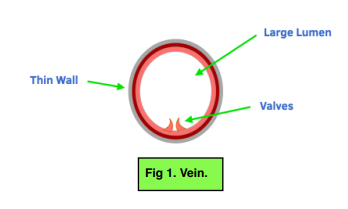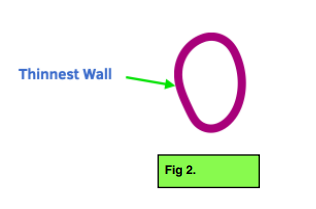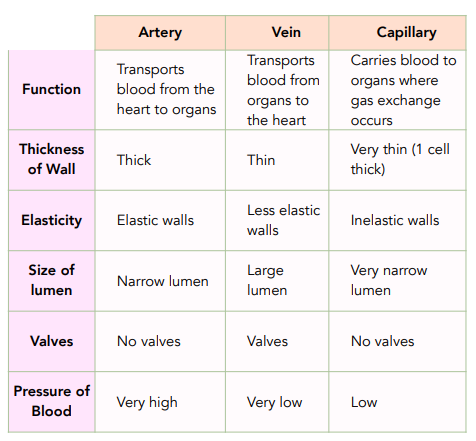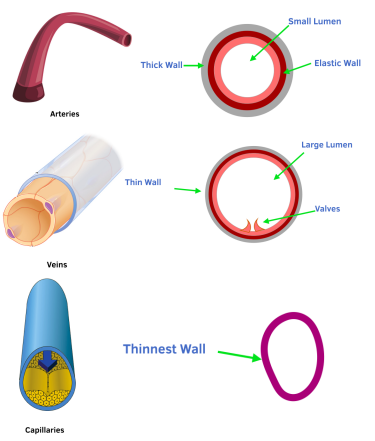Blood and Blood Vessels: Veins and Capillaries (GCSE Biology)
Blood Vessels: Veins and Capillaries
Veins
The veins carry blood slowly back to the heart.
Structure
It is also important to know a brief structure of veins
- Valves are needed – this is to prevent backflow of blood as the pressure of blood flowing in the veins is very low.
- The veins have thin walls and large lumens – this is because the veins don’t have to withstand high pressure.

Venules
- Venules are smaller veins – they have a smaller diameter and come together to form veins
- They connect to capillary beds – they form the venule end of the capillary bed and collect blood from the capillaries to send back to the heart via the veins
- Sometimes veins are directly connected to arteries by shunt vessels – this means capillaries aren’t needed for blood to travel from arteries to the veins.
Capillaries
The capillaries carry blood within organs for exchange.
Structure
It is also important to know a brief structure of capillaries
- They need to be very thin – this is to allow diffusion, in particular diffusion of oxygen in blood to body cells.
- Capillaries don’t need valves either – this is because the pressure from the arterioles before them forces blood to travel in one direction so there is no backflow.
- Capillaries exchange material with surrounding tissue fluid – tissue fluid is the fluid found outside of the vessels and cells. Capillaries can help exchange material between them. Material can move out of the
capillaries into the tissue fluid and vice versa.

Comparison of the Vessels
Below is an overview of the properties all three of the main vessel types:




Blood is a red, viscous fluid that circulates through the body, transporting oxygen, nutrients, and hormones to the cells, and removing waste products and carbon dioxide.
Blood vessels are tubes that transport blood throughout the body. There are three types of blood vessels in the human body: arteries, veins, and capillaries.
Veins are blood vessels that transport blood from the body’s tissues back to the heart. Veins have a larger diameter than arteries and carry oxygen-deprived blood to the heart, where it is then pumped to the lungs for oxygenation.
The role of veins in the circulatory system is to transport blood from the body’s tissues back to the heart. Veins have a larger diameter than arteries and carry oxygen-deprived blood to the heart, where it is then pumped to the lungs for oxygenation.
Capillaries are the smallest and narrowest blood vessels in the human body. They connect the arteries and veins and form a network that allows for the exchange of oxygen, nutrients, and waste products between the blood and the body’s cells.
The role of capillaries in the circulatory system is to provide an exchange of oxygen, nutrients, and waste products between the blood and the body’s cells. Capillaries have a small diameter, allowing for the diffusion of gases and substances between the blood and the body’s cells.
Veins and capillaries work together in the circulatory system by forming a network that allows for the transport of blood and the exchange of gases and substances between the blood and the body’s cells. Blood from the body’s tissues is transported to the heart via veins, and then to the lungs for oxygenation. The oxygen-rich blood is then transported back to the body’s tissues via the capillaries, where the oxygen and nutrients are exchanged with the body’s cells.
The circulatory system helps to maintain homeostasis by transporting oxygen, nutrients, and hormones to the body’s cells and removing waste products and carbon dioxide. The exchange of gases and substances between the blood and the body’s cells through the network of veins and capillaries helps to maintain a stable internal environment in the body, allowing for optimal function and health.
These questions and answers can help students understand veins and capillaries in the circulatory system and prepare them for their GCSE biology exams.






Still got a question? Leave a comment
Leave a comment